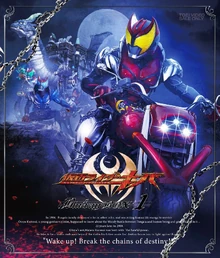Unfinished: Daddy Fight (未完成・ダディ・ファイト, Mikansei: Dadi Faito) is the thirteenth episode of Kamen Rider Kiva. It is the debut of Otoya Kurenai as Kamen Rider Ixa Prototype
Synopsis[]
to be added
Plot[]
In 1986, after visiting Ramon and Riki to discuss their current issues as the last members of their respective kinds, Jiro tells them not to compare himself to them as he vows to restore the Wolfen Race to its former glory and rule the world. The next day, he is about to attack a young lady for nourishment when Otoya interferes, provoking Jiro to beat him to a bloody pulp before he witnesses Garulu devour the woman. Jiro laughs Otoya's insults off and reveals himself as the last of the Wolfen and his plans to make Yuri his mate to repopulate the world with his kind, infuriating Otoya. Otoya is nearly strangled by Jiro but reveals he had secretly lifted the Ixa Knuckle that Jiro dropped in the earlier beating. Transforming into Ixa in front of the shocked and angry Wolfen, Otoya vows that he will never let Jiro near Yuri again as he calmly beats a fighting-mad Garulu into submission; launching the Ixa Knuckle's Broken Fang attack at him.
In 2008, after his defeat by Kiva, Nago becomes mentally disturbed to the point of brutally taking out his rage on a criminal named Yayoi Matsuda, and ends up being arrested himself. Meanwhile, after the IKEMENS band practice, Wataru visits Kengo's home to understand his dream to be a rock star. No sooner does Wataru leave, he encounters Tohru Miyake, a talent agent who witnessed the practice and offers Wataru a professional debut, only to be turned down and suggests Kengo to Miyake's annoyance. The next day, Kengo visits Wataru's place, though unimpressed with Wataru's dream until he is moved by him playing the Bloody Rose. Later, as he ponders his future, Kengo encounters Miyake who offers Kengo the big break he has been looking for, providing Kengo with some needed funding. However, it turns out that Miyake is actually the Rhinoceros Fangire who enjoys feeding on young humans who are working towards their dreams. When Miyake feeds on one of his victims, Wataru arrives and becomes Kiva to fight him. However, the Rhinoceros Fangire proves to be too strong for even Kiva's Basshaa Form to take on as he leaves after giving Kiva a beating
Cast[]
- Wataru Kurenai (紅 渡, Kurenai Wataru): Koji Seto (瀬戸 康史, Seto Kōji)
- Otoya Kurenai (紅 音也, Kurenai Otoya): Kouhei Takeda (武田 航平, Takeda Kōhei)
- Keisuke Nago (名護 啓介, Nago Keisuke): Keisuke Kato (加藤 慶祐, Katō Keisuke)
- Megumi Aso (麻生 恵, Asō Megumi): Nana Yanagisawa (柳沢 なな, Yanagisawa Nana)
- Yuri Aso (麻生 ゆり, Asō Yuri): Yu Takahashi (高橋 優, Takahashi Yū)
- Kengo Eritate (襟立 健吾, Eritate Kengo): Kouhei Kumai (熊井 幸平, Kumai Kōhei)
- Shizuka Nomura (野村 静香, Nomura Shizuka): Rina Koike (小池 里奈, Koike Rina)
- Kivat-Bat the 3rd (キバットバットⅢ世, Kibattobatto Sansei, Voice): Tomokazu Sugita (杉田 智和, Sugita Tomokazu)
- Jiro (次狼, Jirō): Kenji Matsuda (松田 賢二, Matsuda Kenji)
- Ramon (ラモン, Ramon): Yuuki Ogoe (小越 勇輝, Ogoe Yūki)
- Riki (力, Riki): Eiji Takigawa (滝川 英治, Takigawa Eiji)
- Mamoru Shima (嶋 護, Shima Mamoru): Kazuhiko Kanayama (金山 一彦, Kanayama Kazuhiko)
Guest Cast[]
- Tohru Miyake (三宅 徹, Miyake Tōru): Satoshi Jinbo (神保 悟志, Jinbo Satoshi)
- Masataka Yaoi (矢追 正孝, Yaoi Masataka): Naoki Nagase (永瀬 尚希, Nagase Naoki)
- Police: Shun Ito (伊藤 俊, Itō Shun)
- Victim: Rumiko Ohashi (大橋 るみ子, Ōhashi Rumiko), Jun Mitsumune (光宗 潤, Jun Mitsumune)
- Rhinoceros Fangire (ライノセラスファンガイア, Rainoserasu Fangaia, Voice): Ryūsaku Chiziwa (��々和 竜策, Chiziwa Ryūsaku)
Form Changes[]
Kiva: Kiva Form, Basshaa Form
Ixa: Save Mode
Notes[]
- As part of Super Hero Time, this episode aired alongside Engine Sentai Go-Onger
 episode 10, GP 10: Starting Alright
episode 10, GP 10: Starting Alright .
. - Viewership: 6.1%
- Franz Schubert's Symphony No. 8 is commonly known as the "Unfinished Symphony".
- An unfinished symphony is a fragment of a symphony left by composers that are considered incomplete or unfinished for various reasons. The archetypal unfinished symphony is Franz Schubert's Symphony No. 8, written in 1822, six years before his death. It features two fully orchestrated movements. While it seems clear from some sketches that Schubert had intended to create a traditional four-movement symphony, this has been the subject of endless debate. Schubert wrote the symphony for the Graz Musical Society and gave the manuscript to his friend Anselm Hüttenbrenner, in his capacity as its representative. However, Hüttenbrenner did not show the score to the society at that time, nor did he reveal the existence of the manuscript after Schubert died in 1828, but kept it a secret for another 37 years. In 1865, when he was 76 (three years before his death), Hüttenbrenner finally showed it to the conductor Johann von Herbeck, who conducted the extant two movements on the 17th of December 1865 in Vienna, adding the last movement of Schubert's third symphony as the finale. Music historians and scholars then toiled to "prove" the composition was complete in its two-movement form, and indeed, in that form it became one of the most popular pieces in the late 19th century classical music repertoire, and remains one of Schubert's most popular compositions.
- In 1000, the Movie, and the Combatmen, commemorating Kamen Rider 999th episode, this episode was marked red instead of black, in In Sendo's room. This is because it is recognized a great day for Shocker.
DVD releases[]

Kamen Rider Kiva Volume 4, DVD cover
Kamen Rider Kiva Volume 4 features episodes 13-16: Unfinished: Daddy Fight, Pomp and Circumstance: Thunderstrike Purple Eye, Resurrection: Checkmate Four and Player: The Rules of Cruelty.

Kamen Rider Kiva Box 1, Blu-ray cover
Blu-ray Box 1 comes with 16 episodes.
